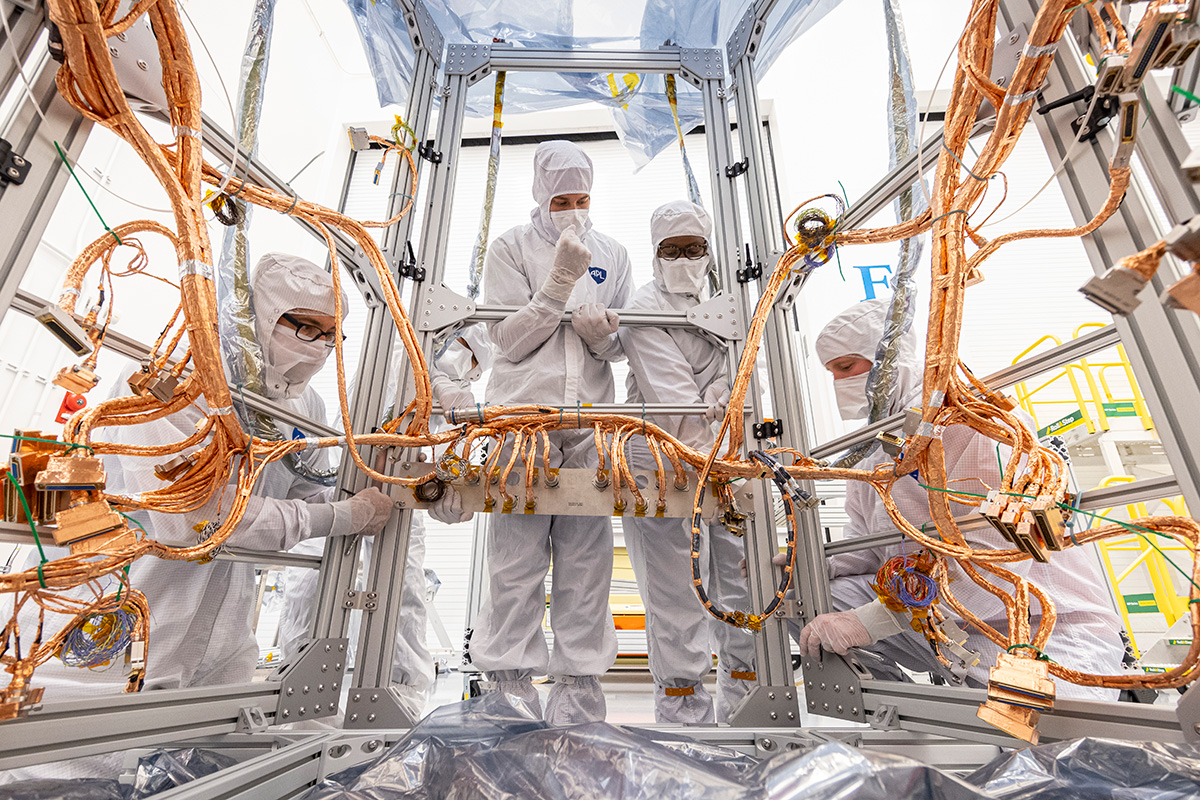
Space Labs and Facilities
APL is recognized as a leader in mission design and navigation; instrument development; mechanical engineering; mechanical design, thermal, and instrument accommodation; communications hardware; electrical subsystems and power; precision timekeeping devices; mission operations, and scientific research. Our facilities are essential to support our spaceflight build process and scientific discoveries.
APL operates with an AS9100C-certified quality management system. That certification is specific to the Laboratory’s spaceflight program management, systems engineering, design, development, production, integration, test, and operation processes. APL maintains an impressive record of delivering high-quality space systems on time and on budget.
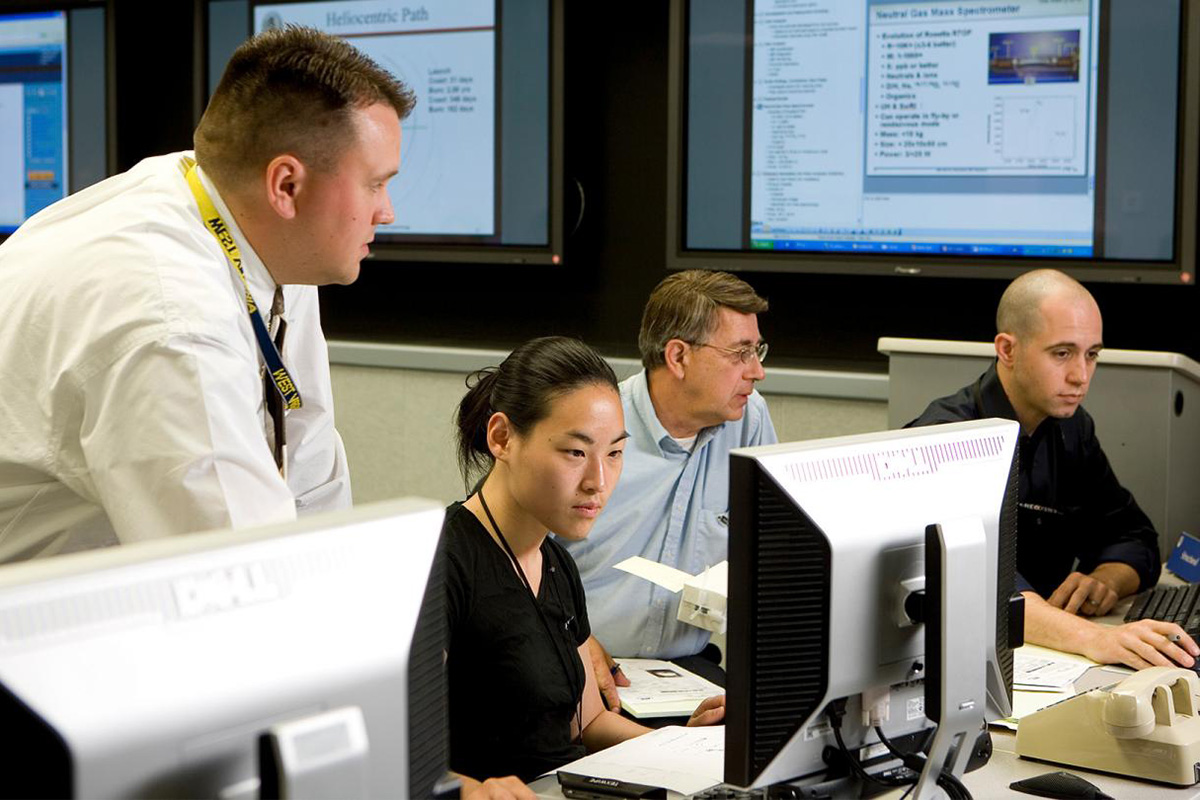
ACE Laboratory
The APL Concurrent Engineering Laboratory (ACE Lab) is more than just a facility: It’s an environment built to foster collaboration and bring the talent of APL’s scientists, engineers, and leaders together so they can help rapidly develop innovative, groundbreaking, and competitive space mission concepts.
Equipped with networked workstations, wireless access, four large displays, drawing boards, modular table configurations, and a moveable wall that can close to isolate a small room for conferencing or open to integrate the entire facility for collaborative work, the ACE Lab is structured to facilitate the collaborative development of a conceptual mission design.
A small team initially identifies the mission’s objective, requirements, constraints, and notional design, after which a full team of APL cognizant engineers and scientists who have been specifically chosen to meet the demands of the project is assembled. Staff members lend their expertise and draw upon their experience from flight programs, utilizing their full suite of tools and extensive library of previous missions and concept documentation to work concurrently in the ACE Lab and arrive at a technical and fiscal solution in typically just a few weeks to a couple of months, depending on the maturity level of the concept being produced.
In just the last decade, this process has been used to develop around 40 pioneering concepts that span the gamut in size — Explorer-, Discovery-, New Frontiers-, and Flagship-class missions — and discipline, including planetary science, space science, and heliophysics. These include NASA’s Parker Solar Probe and Dragonfly missions and, most recently, the Electrojet Zeeman Imaging Explorer or EZIE mission, which will study electric currents in Earth’s atmosphere.
By relying on engineers with extensive project and flight experience, as well as the full capabilities from across the Lab, the design team is better positioned to develop unique and creative solutions grounded in practical application to better address our sponsor’s or stakeholder’s needs.
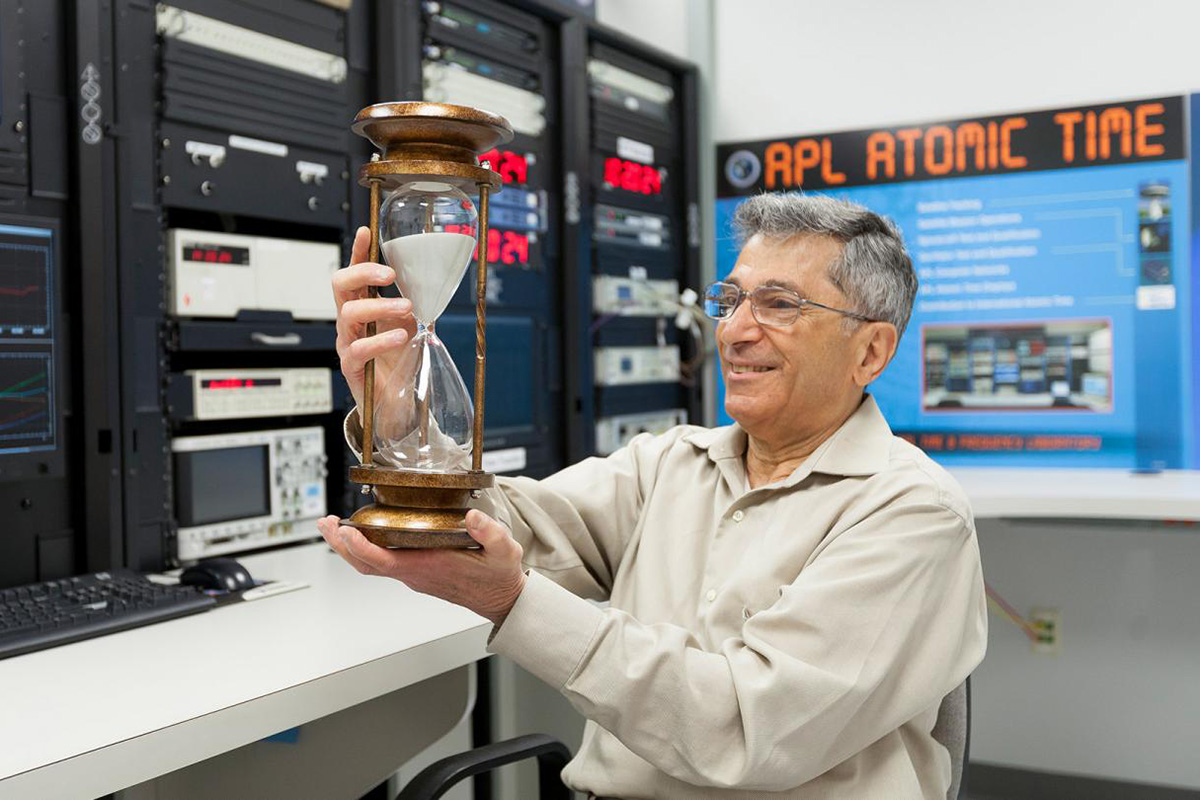
APL Time and Frequency Laboratory
Precision timekeeping is vital to spacecraft positioning and accuracy. APL’s Time and Frequency Lab atomic clocks keep time to less than one billionth of a second to provide support to a variety of NASA and APL space missions in our solar system and beyond. Our engineering support for spacecraft includes providing precise time and frequency to the building and testing of spacecraft parts, evaluating the accuracy of the timekeeping systems, tracking and communicating with the spacecraft, and time-stamping data packets. APL’s Time and Frequency Lab was first established in 1959 under the Lab’s Transit program, the forerunner to the Global Positioning System (GPS) we rely on today for accurate timekeeping and position determination.
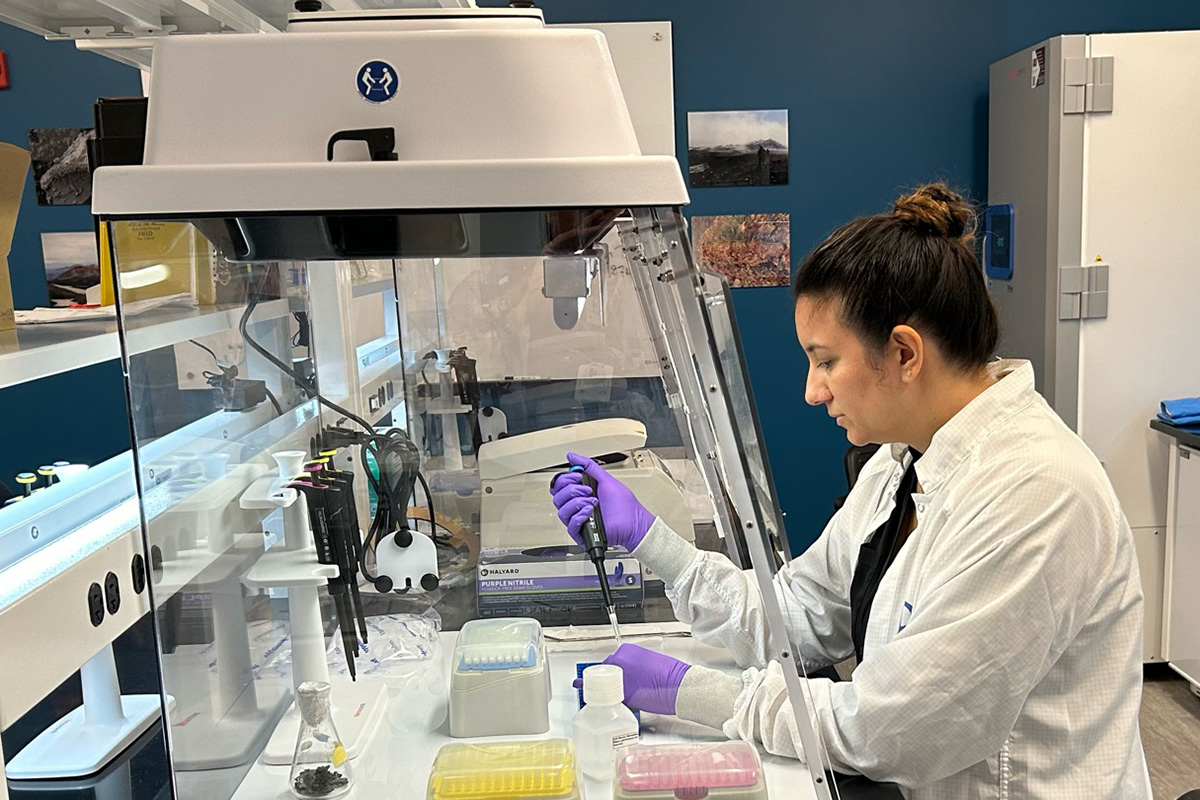
Astrobiology Laboratory
The Astrobiology Lab is designed for researchers to analyze samples of environments on Earth that serve as analogs to past or present liquid-water environments on worlds across the solar system. The temperature- and humidity-controlled facility supports analog and experimental studies into biosignature formation and degradation in Martian and ocean world environments. The lab features positive-pressure decontamination, ultrapure water sources, laminar flow hoods, instrumentation for DNA quantification, various sample preparation facilities, several types of microscopes, and a -80˚ C (-112˚ F) freezer for sample storage. Samples retrieved from Martian and ocean world analog areas—such as saline lakes, hot springs, or groundwater and soil environments—can be subjected to a full battery of microscopic biological and geological investigations.

Environmental Test Facility
Spaceflight hardware must go through a rigorous qualification process before being flown, and APL’s Environmental Test Facility (ETF) has the means to perform every necessary test. The ETF is composed of laboratories, instrumentation, and data‐acquisition equipment for thorough thermal vacuum, static-dynamic, and electromagnetic interference and compatibility environmental testing of flight hardware at all levels of assembly. It offers a variety of capabilities, including vibration, thermal vacuum, and electromagnetic effects. The Space Simulation Laboratory, for example, provides all necessary services and equipment to perform thermal, temperature, humidity, altitude, and thermal vacuum testing of spacecraft and subsystems. The Vibration Test Laboratory provides all services and equipment to perform structural qualification testing of spacecraft and subsystems. Multiple shaker tables are available to suit project needs. And the Electromagnetic Compatibility Test Laboratory provides the services and equipment to perform industry-standard qualification testing of spacecraft and subsystems.
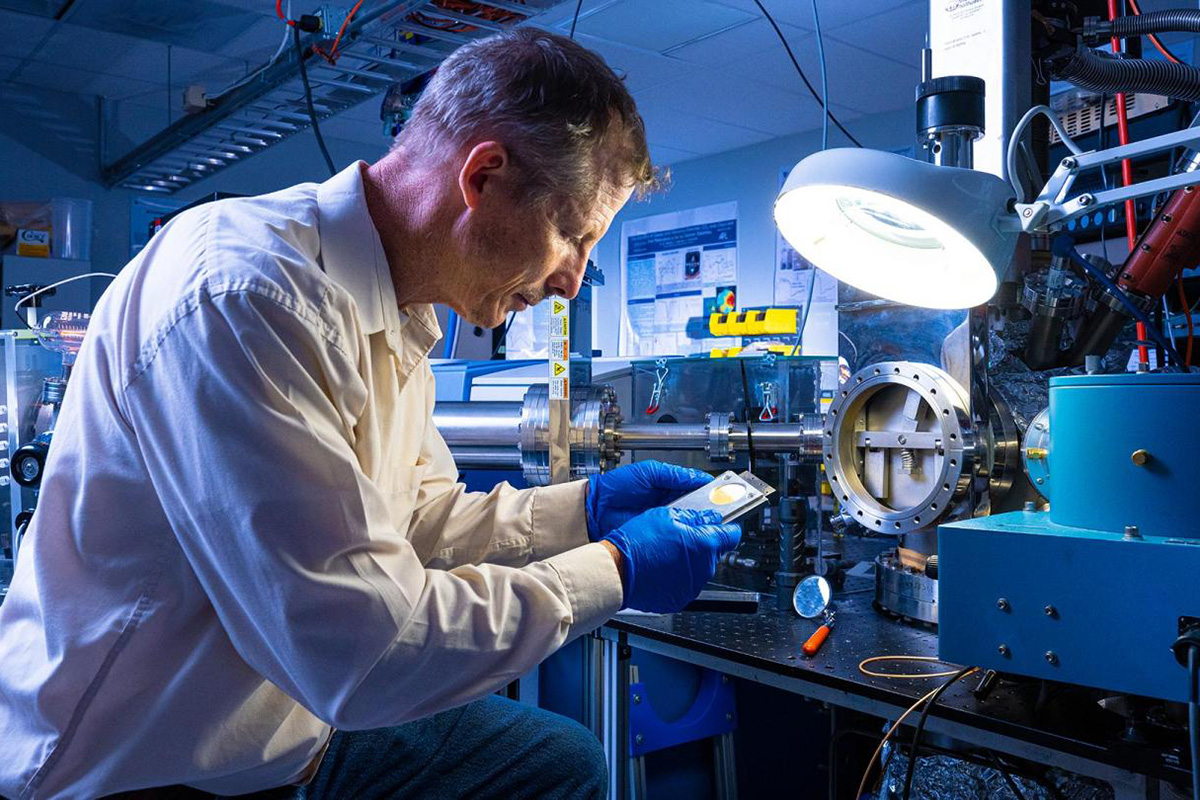
LabSPEC
The Laboratory for Spectroscopy under Planetary Environmental Conditions (LabSPEC) contains two vacuum environmental chambers used to conduct reflectance spectroscopy and experiments.
The ultra-high-vacuum (UHV) environmental chamber allows scientists to replicate the pressure and temperature conditions present at a wide range of airless planetary bodies, such as asteroids. The chamber is equipped with spectrometers to conduct reflectance spectroscopy in the ultraviolet, visible, and near-infrared environments. An ion gun, an electron gun, and a laser are attached to the UHV chamber that can be used to understand the effects of radiation on the surfaces of airless planetary bodies.
The Material Reflectance Spectroscopy vacuum environmental chamber provides visible to near-infrared reflectance wavelength spectroscopy under low pressures (roughly 100,000 times lower than atmospheric pressures), while samples can be dosed with liquids (brines, for example) to explore aqueous alteration processes on planetary surfaces and give insight into how features form.
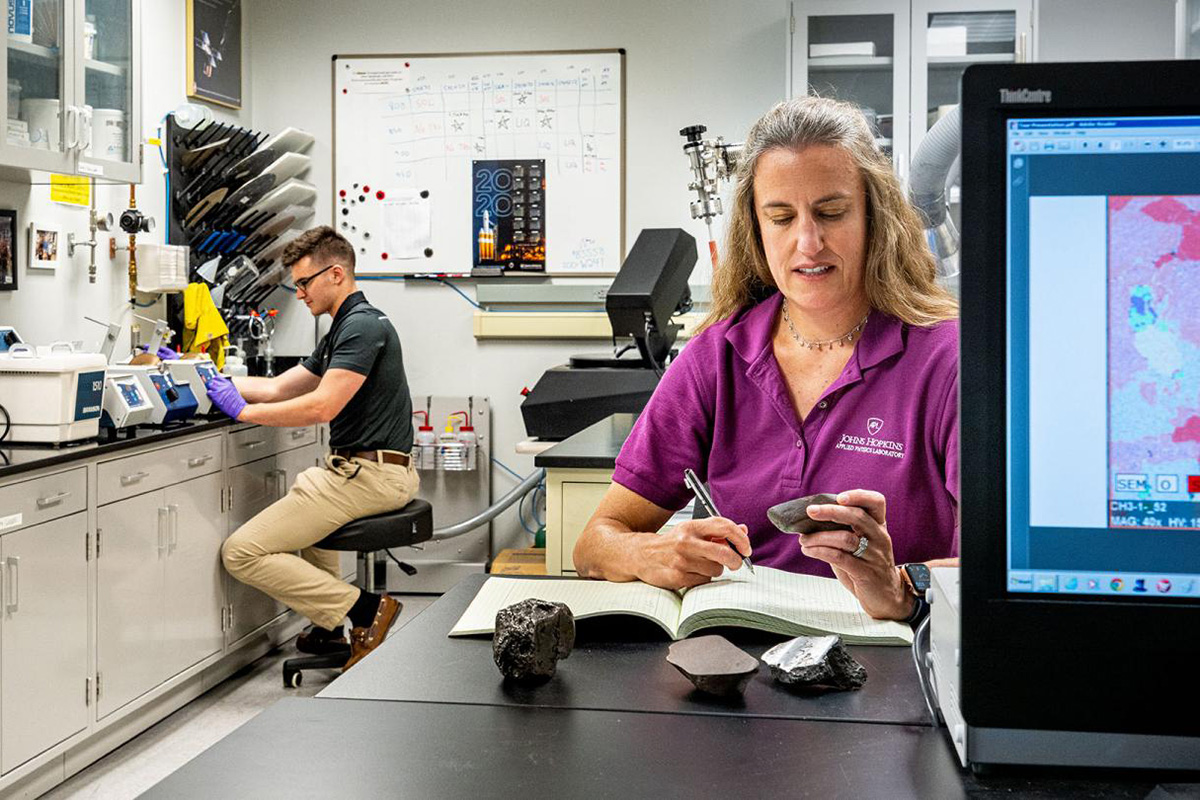
Meteorite Laboratory
The Meteorite Lab has a number of geochemistry and experimental instruments that are used to investigate and understand the chemical processes that operate in our solar system. The lab has the capability to conduct experiments that mimic the high temperatures and pressures inside rocky planets, moons, or asteroids. It is equipped with sample preparation equipment, which enables samples to be ground, sieved, dried, mounted, cleaned, cut, polished, and stored. Petrographic and binocular microscopes are available to characterize samples and capture digital images. A tabletop scanning electron microscope captures high-magnification images to roughly a micron in scale, and the lab’s energy dispersive X-ray spectrometer measures the object’s composition. The Meteorite Lab supports studies of extraterrestrial samples, including meteorites and samples from the Moon, projects for spacecraft instrument development, and experimental investigations of the formation and evolution of planetary bodies.
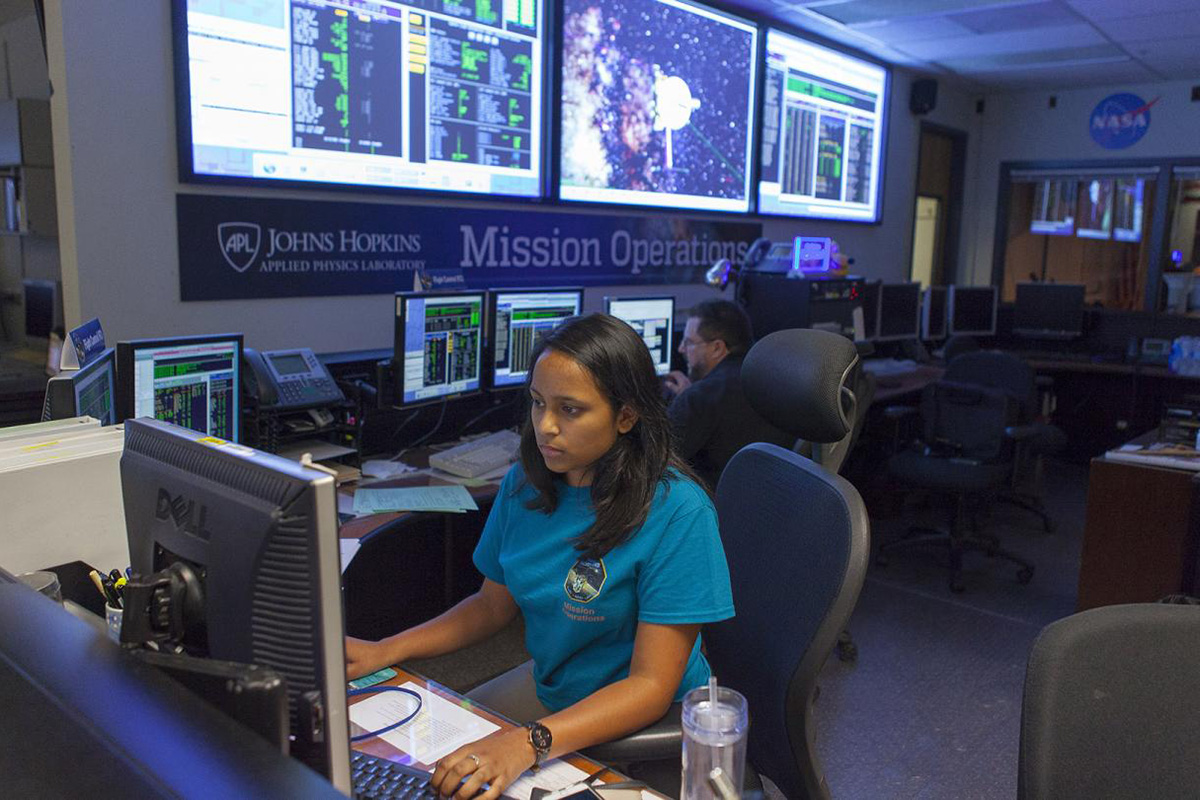
Multimission Operations Center
The Mission Operations Center (MOC) is the command center for operational spacecraft, and APL can operate several missions at any given time. The Multi-Mission MOC performs operations that span the whole mission, from before launch until the final signal is received from the spacecraft at the end of the mission. Many tests and mission simulations are performed before a spacecraft launches to “check out” the MOC, the spacecraft, and the ground system that will operate certain functions autonomously. During a launch, the MOC is fully staffed, with each person having engineering responsibilities during the first contact with the spacecraft to ensure a successful mission start. From there, operations may be run with or without staff. On a routine day when staff are around, the MOC team ensures the spacecraft is safe and healthy. The staff implement requirements from the science team, any engineering needs, and navigation operations while also verifying and uplinking commands to ensure the spacecraft performs its mission, including major mission milestones like the New Horizons flyby of Pluto and getting MESSENGER in orbit around Mercury. The team also downloads science data and housekeeping telemetry to evaluate the health and safety of the spacecraft and ensure it continues operating successfully. For unattended operations, contact with the spacecraft is managed autonomously by the ground system, which will trigger alerts when attention or intervention is necessary by remote staff. This strategy has offered significant savings compared with around-the-clock staffed operations and has proven to be equally reliable.
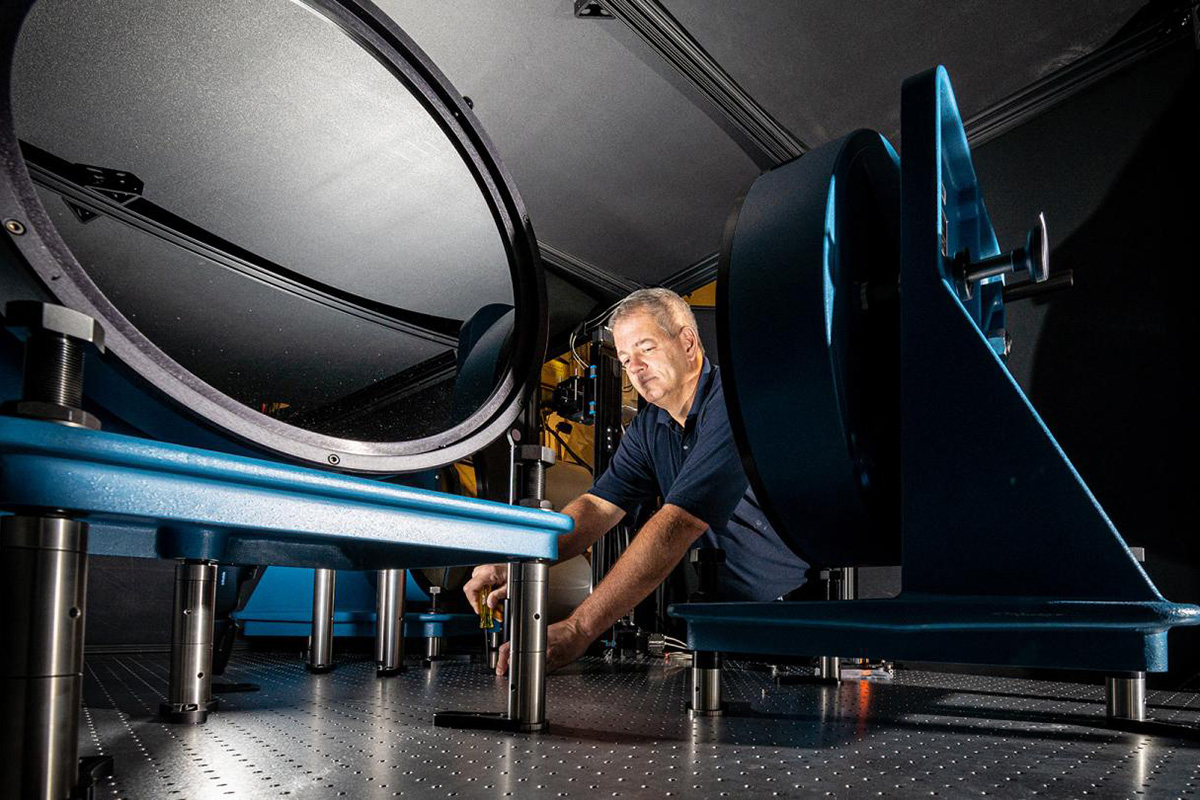
Optical Calibration Facility
APL’s Optical Calibration Facility (OCF) is the proving ground for successful optical instrumentation for spaceflight. In this facility, teams of scientists and engineers work together to calibrate and test the function and performance of space-grade optical instruments in a simulated space environment. The space environment is simulated in two separate chambers. Liquid nitrogen cools the chambers to achieve cryogenic temperatures, and a suite of vacuum pumps evacuates the air and gases to simulate the vacuum of space. Inside the chamber, instruments are steered through two separate, well-characterized windows, allowing multiple optical tests to be conducted without having to reconfigure the test setup. Electrical connections to support equipment that monitors the temperatures, pressures, gases, and instrument performance are made through the wall of the chamber. This preflight characterization and calibration are critical to ensure the optical sensors built at APL meet mission and science requirements.
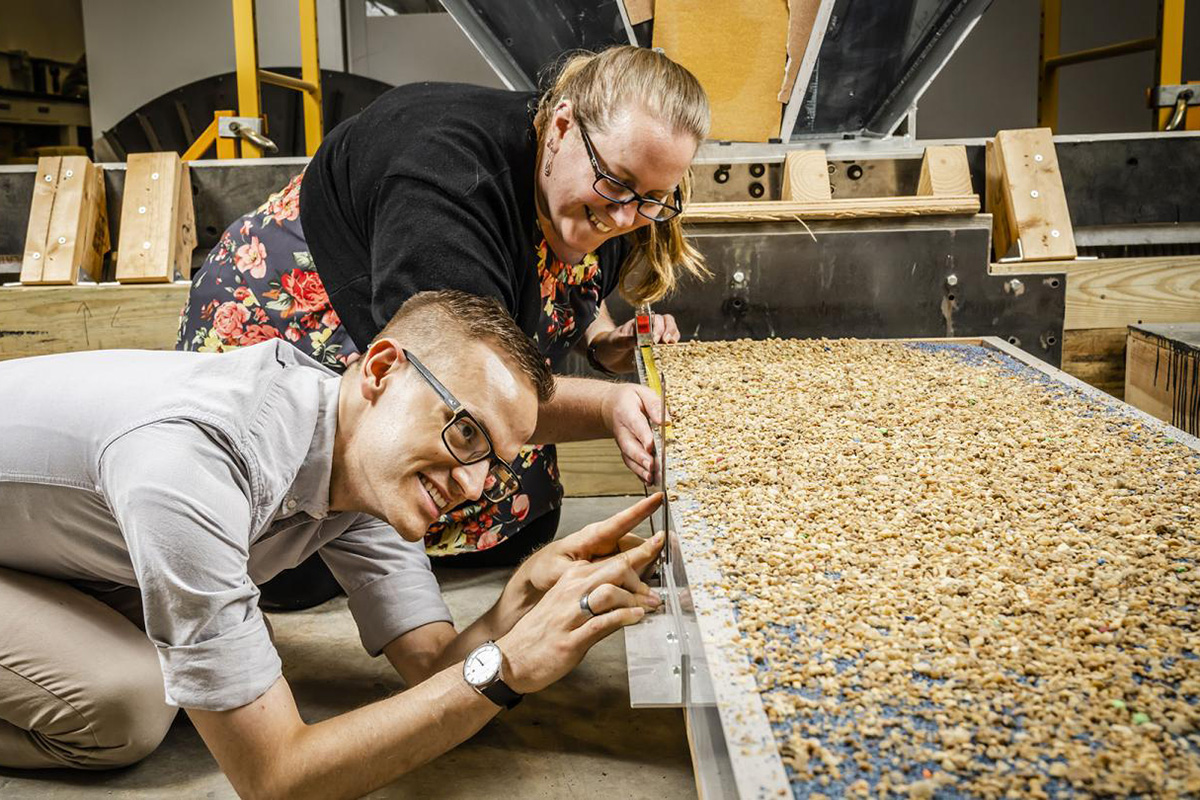
Planetary Impact Lab
APL’s Planetary Impact Lab (PIL) allows researchers to study one of the most widespread processes in the solar system: impact cratering. An impact occurs when one thing in the solar system collides with something else, such as an asteroid with the Moon. Each impact usually leaves behind an impact crater, which can range in size from tens of microns on individual grains collected from the Moon’s surface to enormous basins thousands of kilometers in size. In the PIL, teams of researchers do experiments to study how the outcome of an impact is influenced by factors such as the physical properties of materials and the speed and angle of impact. The results of these experiments are used to interpret observations of impact craters in the solar system, generate novel insights about how impacts work, help improve state-of-the-art computer models, and better understand how to protect Earth from asteroid impacts.
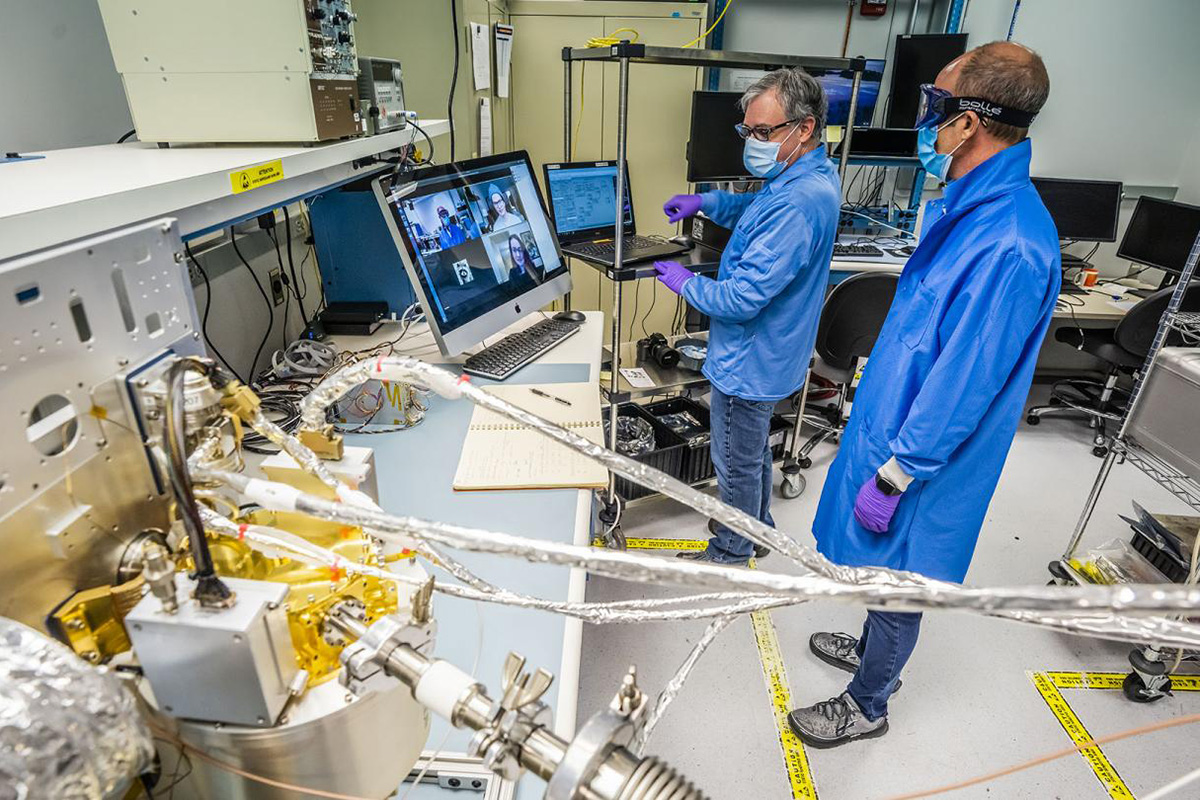
Planetary Nuclear Spectroscopy Laboratory
The Planetary Nuclear Spectroscopy Laboratory contains full instrumentation for developing and testing all types of gamma-ray and neutron sensors that are used for planetary composition measurements. These sensors include multiple high-purity germanium detectors, various scintillator-based systems, and 3Hxe-based neutron sensors. The lab uses commercial electronics to operate and acquire data from these sensors as well as various custom-built packages. Gamma-ray and neutron sensors are tested by using various radioactive sources, which, when used with specialized material (reactor-grade graphite), can simulate the neutron energies that come from a planetary surface. The lab contains a neutron generator that can be operated at a remote site for testing sensors with high levels of neutrons and gamma rays. To approximate planetary materials, the lab houses simulated Martian and lunar soils as well as a variety of rock and meteorite samples. The laboratory is capable of housing the development of engineering and flight-model hardware.

Planetary Protection Laboratory
As NASA missions search for possible signatures of life in our solar system, there’s the real possibility of accidentally introducing microbes from Earth that are hardy enough to survive spaceflight, in turn potentially contaminating other worlds and undermining scientific investigations. APL’s planetary protection team is responsible for ensuring that a mission’s flight hardware is clear of any microbes or other biological hitchhikers. The team uses heat microbial reduction, vapor hydrogen peroxide sterilization, and alcohol cleaning to reduce any biological burdens, and it verifies that all flight hardware are then clear of any living organisms. Any hardy microorganisms are isolated from samples and cultured to allow for quantification. The APL team is currently collaborating with NASA and industry partners to develop the next generation of bioburden evaluation techniques and hardware decontamination methods.
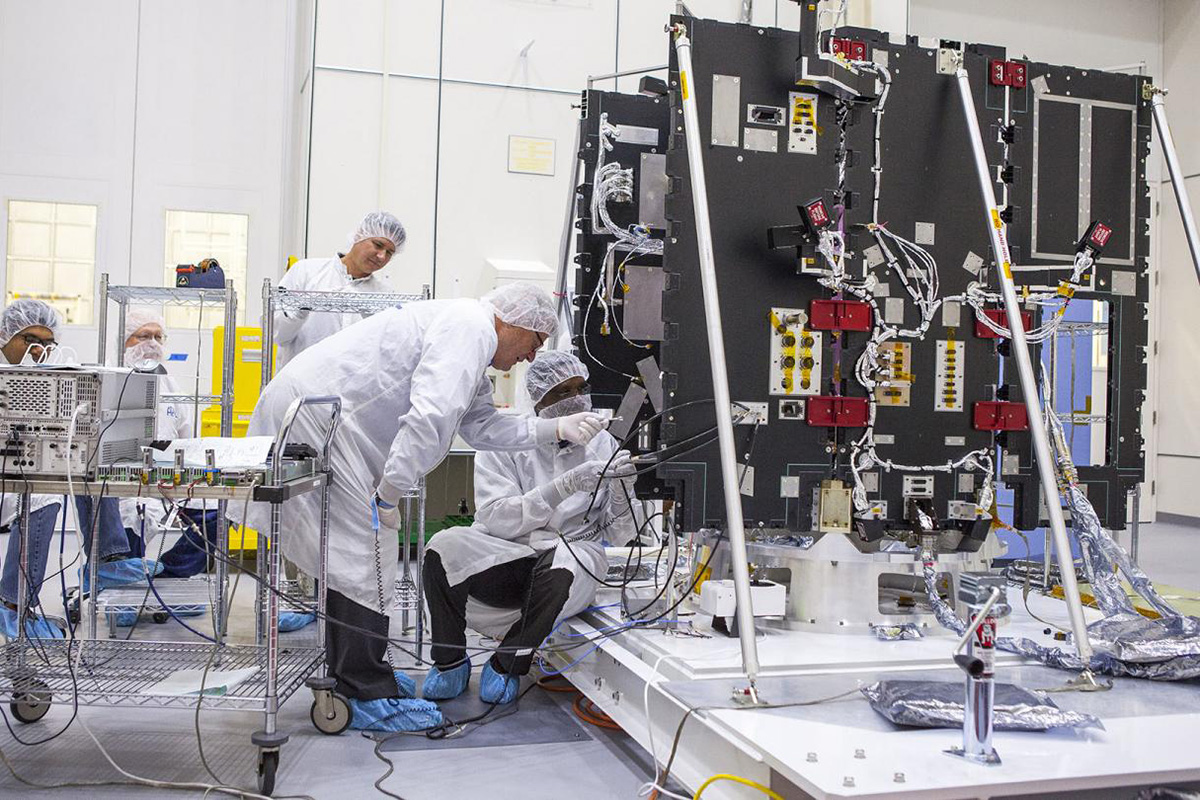
Radio Science Laboratory
APL’s Radio Science Laboratory (RSL) is the locus of development for quick-turnaround design and construction of radio frequency (RF) projects in their proof-of-concept stage. The lab offers agile support to activities that may yield major payoffs down the road. It offers hard-to-find components for the rapid construction of RF systems, assembly of data acquisition systems, and staging before field testing for surface-based measurements, whether from the ground, a ship, an uncrewed aerial vehicle, or a balloon. The RSL supports GPS experiments; high-frequency (HF), very-high-frequency (VHF), and ultra-high-frequency (UHF) field deployments; and system constructions for local testing using calibration and local terrain targets. The lab also houses X-band Doppler systems as well as a wide range of band components and antennas.
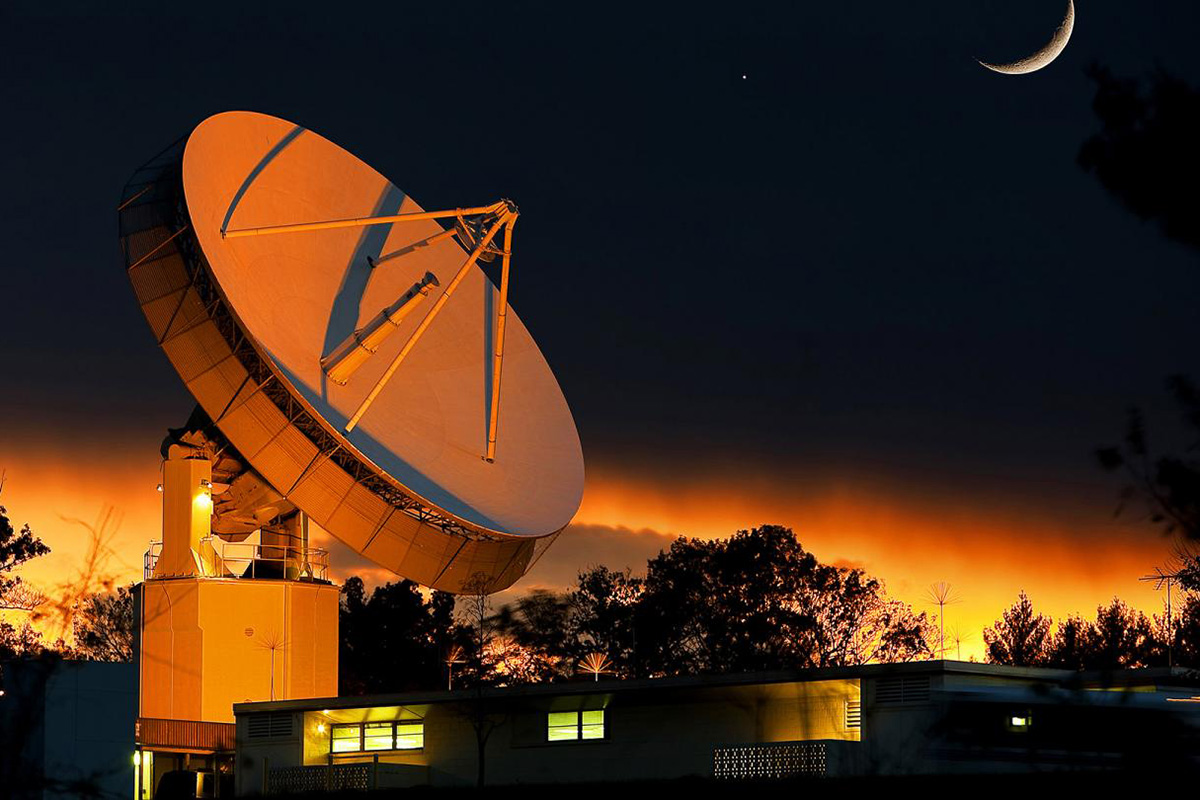
Satellite Communications Facility
Put into service during the early days of Sputnik in 1963 to support the world’s first satellite navigation system, APL’s Satellite Communications Facility (SCF) is one of the oldest operational ground stations in the world. The facility consists of two independent operational antenna systems (18.3 m and 5 m) and provides commanding, ranging, telemetry, and Doppler tracking services for spacecraft missions from numerous sponsor organizations. The SCF supports spacecraft in low Earth orbit (LEO), geosynchronous orbit (GEO), highly elliptical orbit (HEO), lunar orbit, and deep space (out to 2.5 astronomical units, or 2.5 times the average distance between Earth and the Sun). The SCF also serves as a platform for APL engineers and scientists to conduct research and development projects as well as special communication experiments.
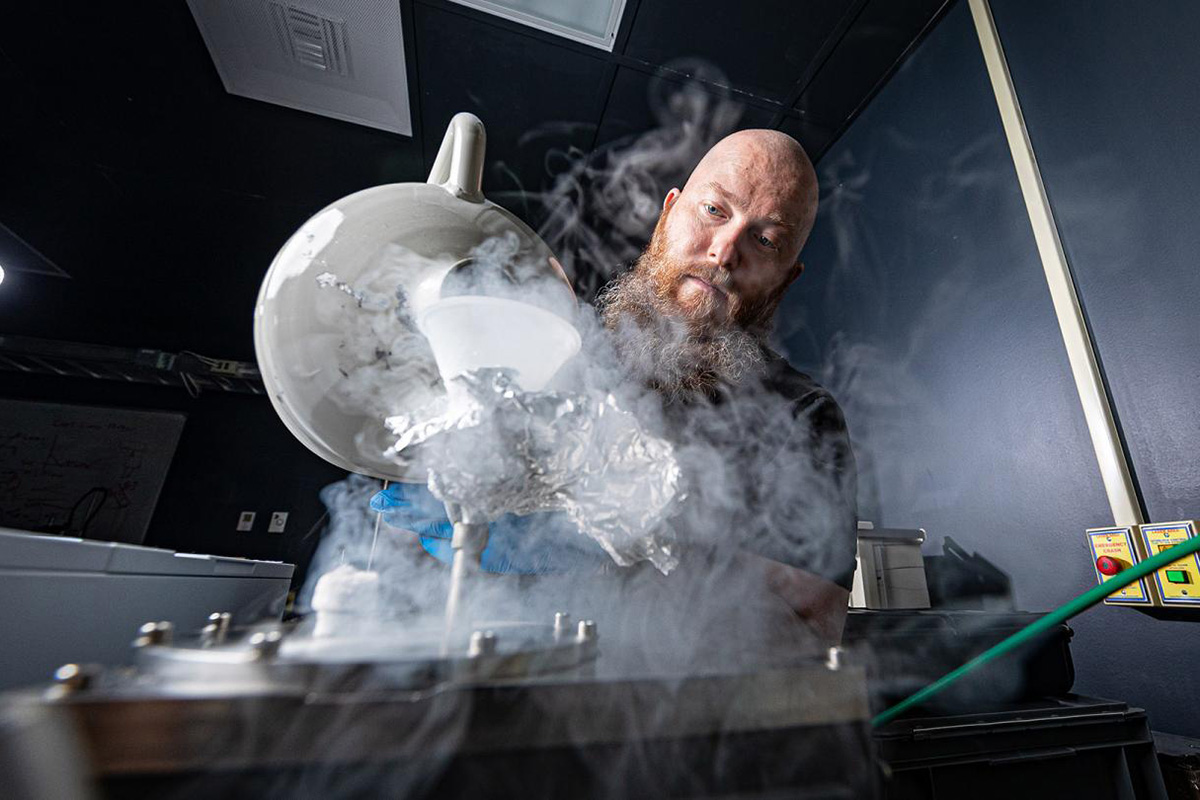
Simulated Airless Body Emission Laboratory
APL’s Simulated Airless Body Emission Laboratory (SABEL) provides a unique capability to study geologic materials in environments relevant to the most abundant class of planetary objects: airless bodies. In these environments, the fine, dustlike particulates that make up the outermost planetary surface emit thermal infrared light in ways that are fundamentally different from terrestrial environments, such as Earth or Mars. SABEL simulates the space environment using a vacuum chamber and liquid-nitrogen-cooled shrouds. Particulate samples are heated using a solarlike lamp, and their thermal emission is measured using a broadband spectrometer. In SABEL, we measure samples as simple as pure minerals and as complex as lunar soils returned by the Apollo missions. As we better understand these materials in the lab, we can design better instruments to measure the materials on airless bodies.
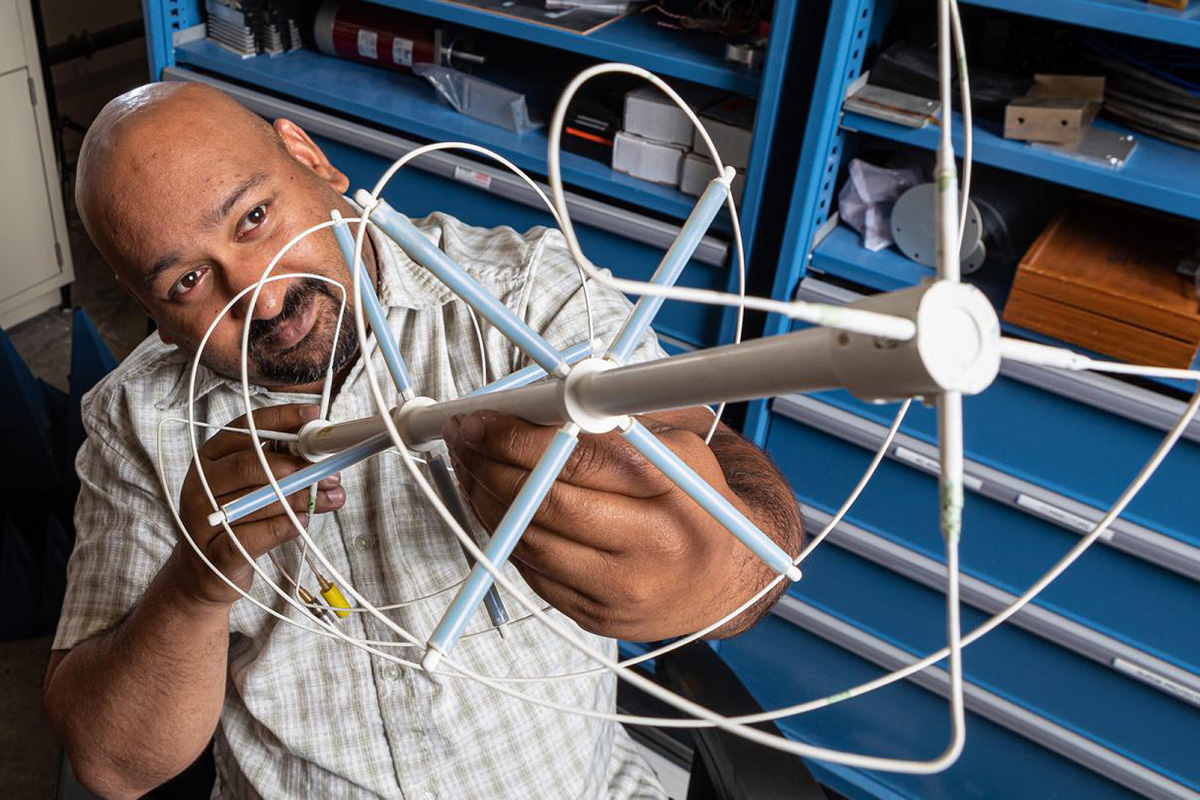
Space Exploration Sector Antenna Test Ranges
Scientists and engineers use APL’s two antenna measurement ranges to develop antennas for a variety of space applications or missions.
The outdoor far-field antenna range is used primarily to characterize the radiation patterns of antennas operating from 100 MHz to 2 GHz, but it can be configured to operate upward of 8 GHz. The facility is more than 200 feet long, with a built-in diffraction fence.
The compact antenna range is used primarily for measuring antennas operating from 2 GHz to over 40 GHz. Full volumetric antenna radiation patterns and radar cross-section measurements are typically performed in this facility.
Both facilities have been used to support the development and final space qualification of antennas for multiple programs, including MESSENGER, New Horizons, Van Allen Probes, Parker Solar Probe, DART, Europa Clipper, IMAP, and Dragonfly.
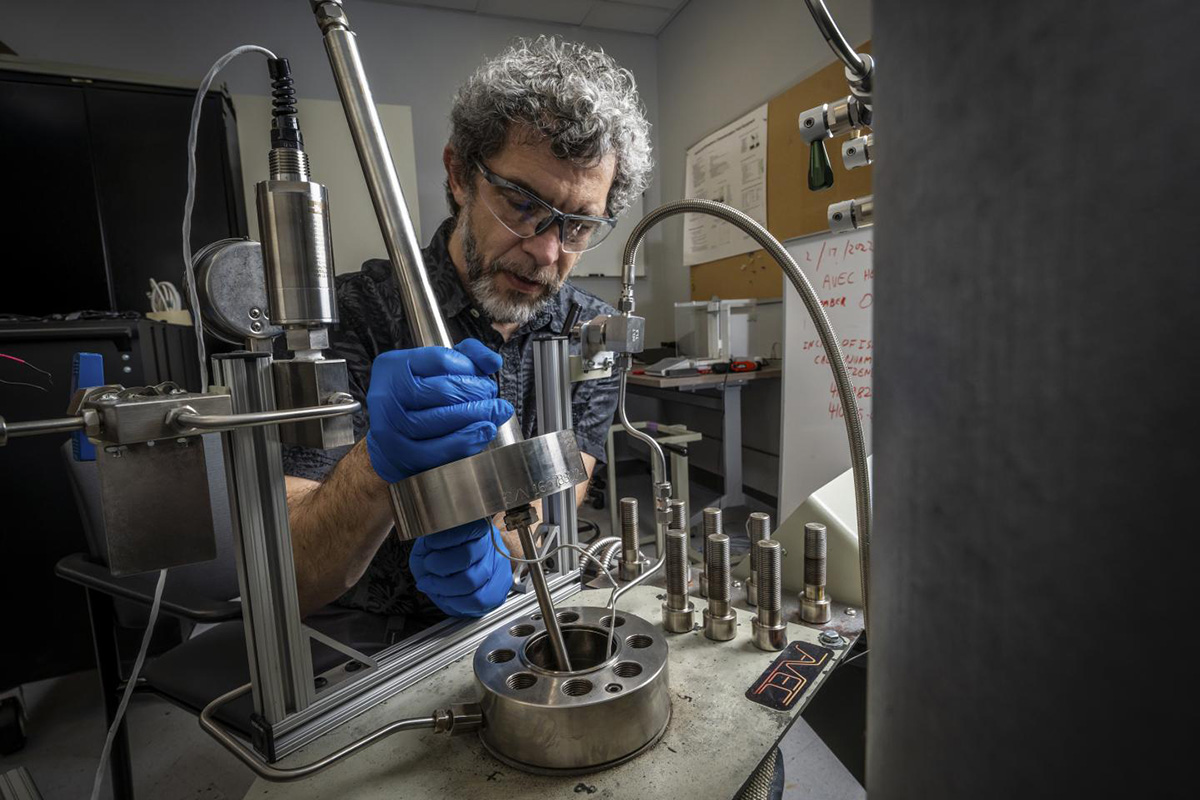
APL Venus Environment Chamber (AVEC)
The APL Venus Environment Chamber (AVEC) is a compact laboratory simulation vessel designed to mimic the pressure, temperature, and atmospheric compositional conditions at the interface between Venus’ (and potentially other planetary bodies’) surface and atmosphere.
Made of the nickel-chromium superalloy Inconel®, AVEC can reach and sustain temperatures ranging from 869 to 878 degrees Fahrenheit (465-470 degrees Celsius) at pressures of 92-96 atmospheres using a gas composition of carbon dioxide, molecular nitrogen, and a trace number of other gases that mimics the lower atmosphere of Venus.
At roughly 2.5 inches (6.4 centimeters) in diameter and 9 inches (23 centimeters) deep, AVEC allows researchers to perform simple gas-solid reaction chemistry experiments, expose samples to Venus-like and other simulated atmospheres at elevated temperature and pressure, and externally monitor simple sensors or devices.
AVEC supports multiple technology development and science research projects within APL and with external partners, including high-temperature materials testing, gas-solid mineral reaction experiments, high-temperature sensor components, other testing for sensor development and mission applications.
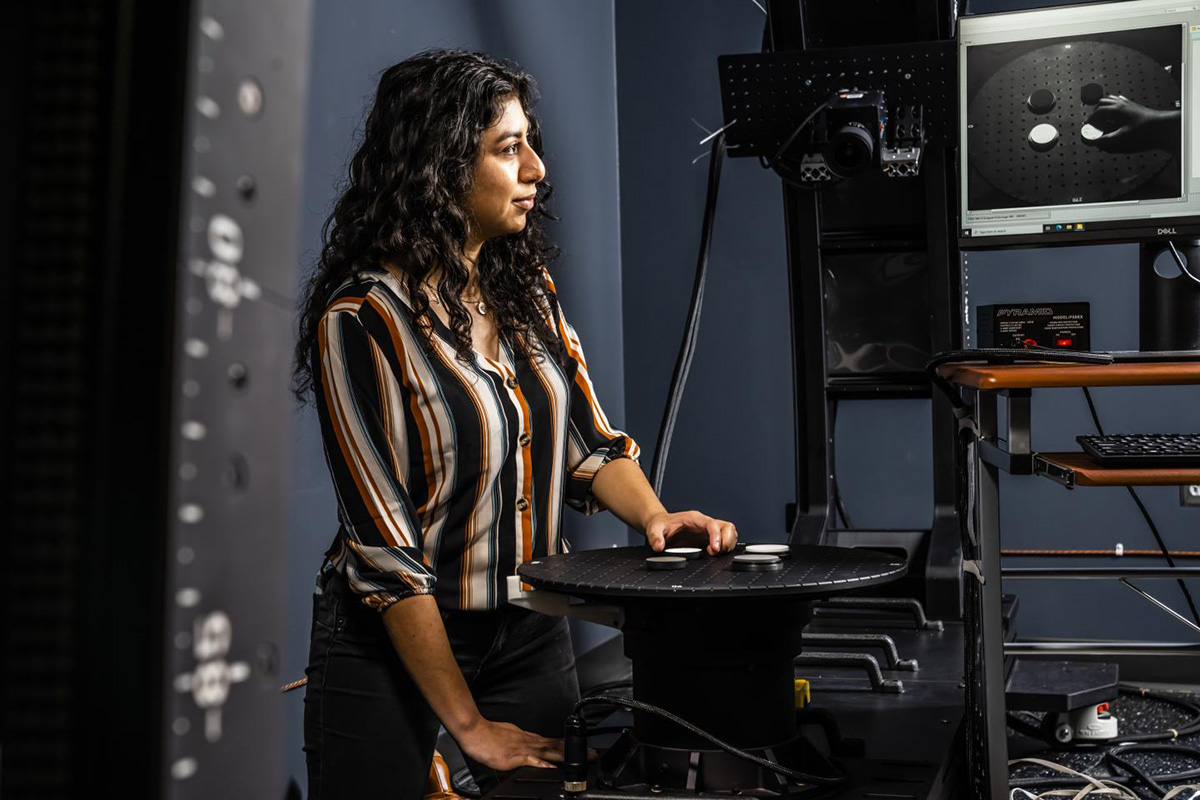
Planetary Surface Texture Laboratory
The Planetary Surface Texture Laboratory (PSTL) allows researchers to investigate how soil-like materials on the surface of planetary bodies—called regolith—reflect light. By knowing this characteristic of the surface, researchers better understand the properties of remotely observed surfaces and, in turn, collect clues about the geologic processes that have shaped those bodies.
PSTL has a specialized camera called a polarimeter to measure the degree to which material samples cause reflected light to become polarized. By mounting the camera and a light source onto a goniometer—an apparatus that allows a person to vary the angles at which the sample is viewed and illuminated—scientists can simulate the conditions that a remote-sensing instrument on a telescope or on a spacecraft would experience while observing a planetary surface. Researchers can then glean information about the composition and texture of the material (including particle size, particle shape and porosity) by determining how the reflectance (or brightness) and polarization of the sample change with the illumination and viewing geometry.
The work conducted in the PSTL will prove particularly useful for interpreting data returned from the Korea Pathfinder Lunar Orbiter (KPLO) spacecraft, South Korea’s first mission to the Moon. Using a polarimeter instrument called PolCam, KPLO will collect extensive polarization images of the Moon to learn more about the nature of the lunar surface and for comparison with other remote-sensing datasets, such as reflectance spectroscopy, thermal emission, and radar backscatter.
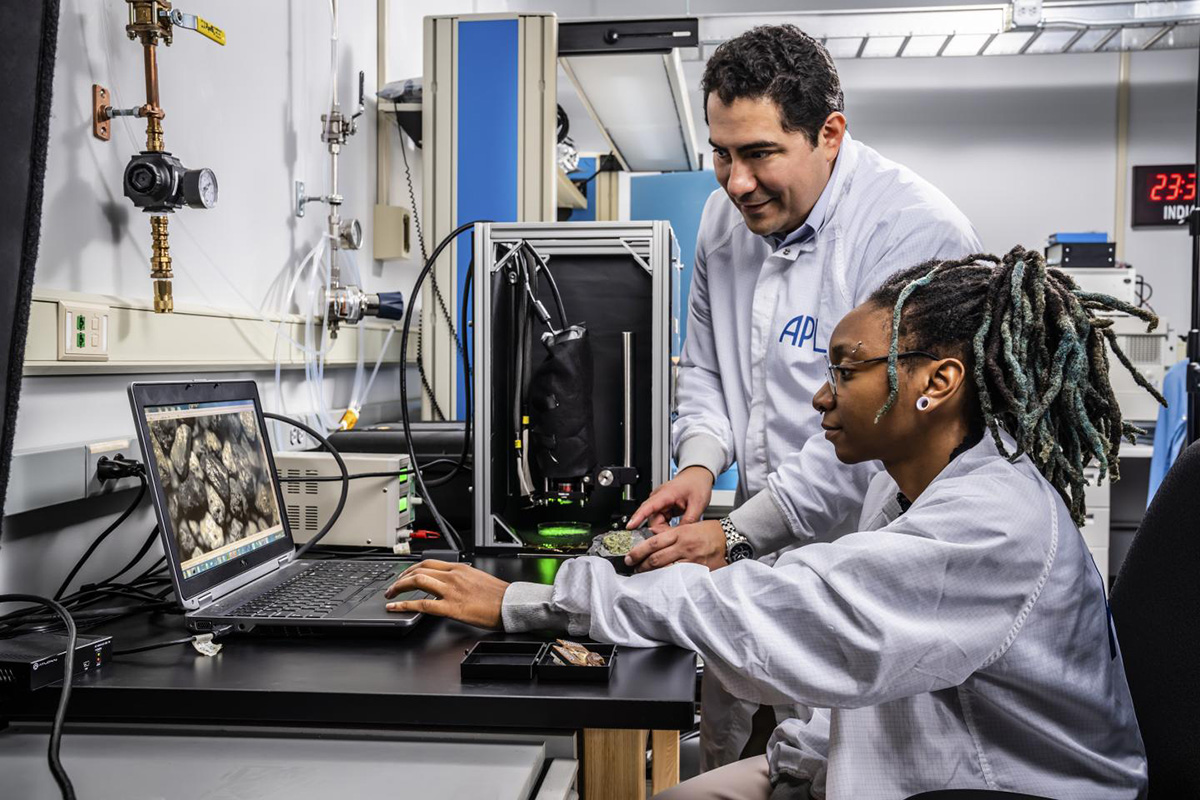
Planetary Exploration Research Laboratory (PERL)
The Planetary Exploration Research Laboratory (PERL) houses more than nine projects that range from fundamental research to enhance the scientific return of NASA missions, to hardware testing and instrument development for current and future missions, respectively. Each project represents APL’s strongest focus areas and depth of capability.
Fundamental research is conducted using the Geological Near-IR Optimized Microspectroscopic Experiment (GNOME), a microscope optimized for measuring small, thin samples of rock in light ranging from visible to mid-infrared wavelengths. This capability helps researchers understand how spectra collected by spacecraft around planetary bodies relate to the mineral and rock composition of those bodies.
In instrument development and hardware testing, engineers are testing the prototype lidar system for NASA’s Dragonfly mission. The instrument will send pulses of laser light to determine the presence, shape, and distance of objects on the surface of Saturn’s moon Titan. Ongoing performance tests are verifying the instrument’s capability to produce the necessary precision for properly identifying ground hazards, such as rocks and slopes, ensuring Dragonfly can land safely as it explores the prebiotic chemistry on Titan’s surface.
APL researchers are also developing the Advanced Multispectral Infrared Microimager (AMIM) and its associated electronics breadboard. Designed with LED arrays that can be customized for specific planetary surfaces and compositions, AMIM is being developed for Dragonfly’s DragonCam Microscopic Imager to produce nine-band multispectral images of Titan’s surface as well as for use on future missions to the Moon’s surface.
PERL also supports team members on iSTART, an ultraviolet-visible (UV-Vis) spectrometer that will autonomously track low-Earth-orbit satellites for space situational awareness. iSTART will also contribute to the scientific understanding of the transmission of Earth’s atmosphere in the UV-Vis spectral range.
Finally, engineers are conducting flight hardware tests on the electronics brass board of the Mini-RF instrument on NASA’s Lunar Reconnaissance Orbiter. These tests confirm nonstandard command instrument sequences before uploading them to the spacecraft.
PERL also houses a rock crusher, magnetic separator, and ultrasonic bath for preparing samples for the Simulated Airless Body Emission Laboratory (SABEL), which supports various missions with thermal infrared spectrometers. A freezer also provides storage for cryogenic samples used to understand the mechanisms and compositions responsible for colors on outer solar icy satellites, such as Jupiter’s moon Europa.